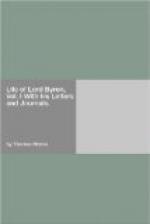During this period, his mother and he made, occasionally, visits among their friends, passing some time at Fetteresso, the seat of his godfather, Colonel Duff, (where the child’s delight with a humorous old butler, named Ernest Fidler, is still remembered,) and also at Banff, where some near connections of Mrs. Byron resided.
In the summer of the year 1796, after an attack of scarlet-fever, he was removed by his mother for change of air into the Highlands; and it was either at this time, or in the following year, that they took up their residence at a farm-house in the neighbourhood of Ballater, a favourite summer resort for health and gaiety, about forty miles up the Dee from Aberdeen. Though this house, where they still show with much pride the bed in which young Byron slept, has become naturally a place of pilgrimage for the worshippers of genius, neither its own appearance, nor that of the small bleak valley, in which it stands, is at all worthy of being associated with the memory of a poet. Within a short distance of it, however, all those features of wildness and beauty, which mark the course of the Dee through the Highlands, may be commanded. Here the dark summit of Lachin-y-gair stood towering before the eyes of the future bard; and the verses in which, not many years afterwards, he commemorated this sublime object, show that, young as he was, at the time, its “frowning glories” were not unnoticed by him.[17]
Ah, there my young footsteps
in infancy wandered,
My cap was the
bonnet, my cloak was the plaid;
On chieftains long perish’d
my memory ponder’d
As daily I strode
through the pine-cover’d glade.
I sought not my home till
the day’s dying glory
Gave place to
the rays of the bright polar-star;
For Fancy was cheer’d
by traditional story,
Disclosed by the
natives of dark Loch-na-gar.
To the wildness and grandeur of the scenes, among which his childhood was passed, it is not unusual to trace the first awakening of his poetic talent. But it may be questioned whether this faculty was ever so produced. That the charm of scenery, which derives its chief power from fancy and association, should be much felt at an age when fancy is yet hardly awake, and associations but few, can with difficulty, even making every allowance for the prematurity of genius, be conceived. The light which the poet sees around the forms of nature is not so much in the objects themselves as in the eye that contemplates them; and Imagination must first be able to lend a glory to such scenes, before she can derive inspiration from them. As materials, indeed, for the poetic faculty, when developed, to work upon, these impressions of the new and wonderful retained from childhood, and retained with all the vividness of recollection which belongs to genius, may form, it is true, the purest and most precious part of that aliment, with which the memory of the poet feeds his




